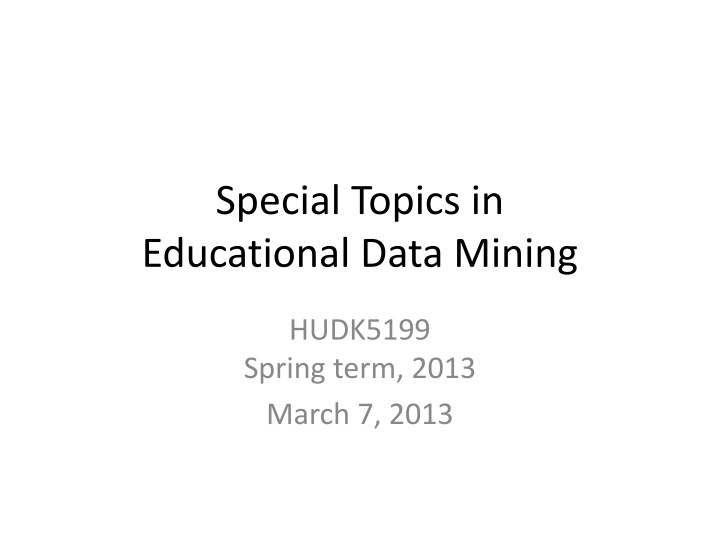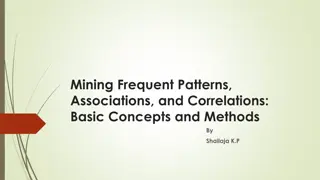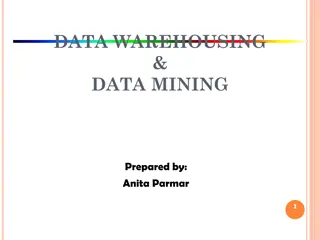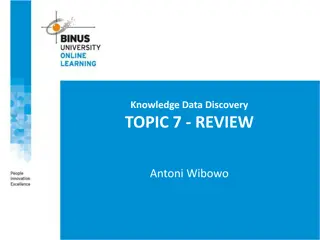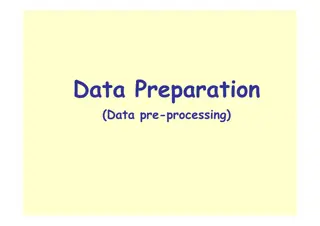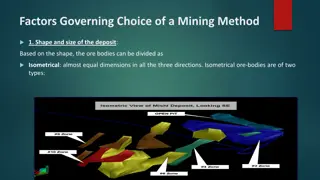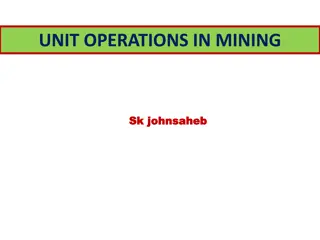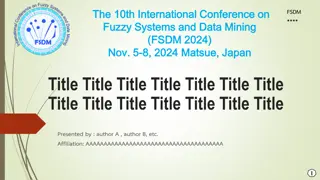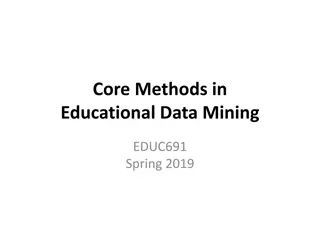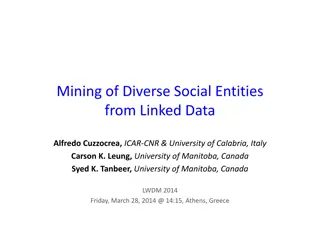Special Topics in Educational Data Mining
In the field of educational data mining, regression plays a crucial role in predicting numerical outcomes such as student performance. This content delves into regression techniques, focusing on linear regression and its application in educational contexts. Linear regression is explored as a fundamental tool for predicting outcomes based on a combination of features. The content emphasizes the importance of identifying relevant features to accurately predict the desired label value. Additionally, it discusses the limitations of linear regression and its applicability in fitting linear functions.
Uploaded on Feb 28, 2025 | 3 Views
Download Presentation

Please find below an Image/Link to download the presentation.
The content on the website is provided AS IS for your information and personal use only. It may not be sold, licensed, or shared on other websites without obtaining consent from the author.If you encounter any issues during the download, it is possible that the publisher has removed the file from their server.
You are allowed to download the files provided on this website for personal or commercial use, subject to the condition that they are used lawfully. All files are the property of their respective owners.
The content on the website is provided AS IS for your information and personal use only. It may not be sold, licensed, or shared on other websites without obtaining consent from the author.
E N D
Presentation Transcript
Special Topics in Educational Data Mining HUDK5199 Spring term, 2013 March 7, 2013
Todays Class Regression in Prediction
Regression in Prediction There is something you want to predict ( the label ) The thing you want to predict is numerical Number of hints student requests How long student takes to answer What will the student s test score be
Regression in Prediction A model that predicts a number is called a regressor in data mining The overall task is called regression
Regression Associated with each label are a set of features , which maybe you can use to predict the label Skill ENTERINGGIVEN ENTERINGGIVEN USEDIFFNUM ENTERINGGIVEN REMOVECOEFF REMOVECOEFF USEDIFFNUM . pknow 0.704 0.502 0.049 0.967 0.792 0.792 0.073 time 9 10 6 7 16 13 5 totalactions 1 2 1 3 1 2 2 numhints 0 0 3 0 1 0 0
Regression The basic idea of regression is to determine which features, in which combination, can predict the label s value Skill ENTERINGGIVEN ENTERINGGIVEN USEDIFFNUM ENTERINGGIVEN REMOVECOEFF REMOVECOEFF USEDIFFNUM . pknow 0.704 0.502 0.049 0.967 0.792 0.792 0.073 time 9 10 6 7 16 13 5 totalactions 1 2 1 3 1 2 2 numhints 0 0 3 0 1 0 0
Linear Regression The most classic form of regression is linear regression There are courses called regression at a lot of universities that don t go beyond linear regression
Linear Regression The most classic form of regression is linear regression Numhints = 0.12*Pknow + 0.932*Time 0.11*Totalactions Skill COMPUTESLOPE pknow 0.544 time 9 totalactions 1 numhints ?
Linear Regression Linear regression only fits linear functions (except when you apply transforms to the input variables, which most statistics and data mining packages can do for you )
Non-linear inputs What kind of functions could you fit with Y = X2 Y = X3 Y = sqrt(X) Y = 1/x Y = sin X Y = ln X
Linear Regression However It is blazing fast It is often more accurate than more complex models, particularly once you cross-validate Caruana & Niculescu-Mizil (2006) It is feasible to understand your model (with the caveat that the second feature in your model is in the context of the first feature, and so on)
Example of Caveat Let s study a classic example
Example of Caveat Let s study a classic example Drinking too much prune nog at a party, and having to make an emergency trip to the Little Researcher s Room
Data Some people are resistent to the deletrious effects of prunes and can safely enjoy high quantities of prune nog!
Learned Function Probability of emergency = 0.25 * # Drinks of nog last 3 hours - 0.018 * (Drinks of nog last 3 hours)2 But does that actually mean that (Drinks of nog last 3 hours)2 is associated with less emergencies ?
Learned Function Probability of emergency = 0.25 * # Drinks of nog last 3 hours - 0.018 * (Drinks of nog last 3 hours)2 But does that actually mean that (Drinks of nog last 3 hours)2 is associated with less emergencies ? No!
Example of Caveat 1.2 1 Number of emergencies 0.8 0.6 0.4 0.2 0 8.8 9 9.2 9.4 9.6 9.8 10 Number of drinks of prune nog (Drinks of nog last 3 hours)2 is actually positively correlated with emergencies! r=0.59
Example of Caveat 1.2 1 Number of emergencies 0.8 0.6 0.4 0.2 0 8.8 9 9.2 9.4 9.6 9.8 10 Number of drinks of prune nog The relationship is only in the negative direction when (Drinks of nog last 3 hours) is already in the model
Example of Caveat So be careful when interpreting linear regression models (or almost any other type of model)
Regression Trees (non-linear; RepTree) If X>3 Y = 2 else If X<-7 Y = 4 Else Y = 3
Linear Regression Trees (linear; M5 ) If X>3 Y = 2A + 3B else If X< -7 Y = 2A 3B Else Y = 2A + 0.5B + C
Create a Linear Regression Tree to Predict Emergencies
Model Selection in Linear Regression Greedy M5 None
Neural Networks Another popular form of regression is neural networks (also called Multilayer Perceptron) This image courtesy of Andrew W. Moore, Google http://www.cs.cmu.edu/~awm/tutorials
Neural Networks Neural networks can fit more complex functions than linear regression It is usually near-to-impossible to understand what the heck is going on inside one
In fact The difficulty of interpreting non-linear models is so well known, that they put up a sign about it on the Belt Parkway
And of course There are lots of fancy regressors in Data Mining packages like RapidMiner Support Vector Machine Poisson Regression LOESS Regression ( Locally weighted scatterplot smoothing ) Regularization-based Regression (forces parameters towards zero) Lasso Regression ( Least absolute shrinkage and selection operator ) Ridge Regression
Assignment 5 Let s discuss your solutions to assignment 5
How can you tell if a regression model is any good?
How can you tell if a regression model is any good? Correlation/r2 RMSE/MAD What are the advantages/disadvantages of each?
Cross-validation concerns The same as classifiers
Statistical Significance Testing F test/t test But make sure to take non-independence into account! Using a student term
Statistical Significance Testing F test/t test But make sure to take non-independence into account! Using a student term (but note, your regressor itself should not predict using student as a variable unless you want it to only work in your original population)
As before You want to make sure to account for the non- independence between students when you test significance An F test is fine, just include a student term (but note, your regressor itself should not predict using student as a variable unless you want it to only work in your original population)
Alternatives Bayesian Information Criterion Akaike Information Criterion Makes trade-off between goodness of fit and flexibility of fit (number of parameters) Said to be statistically equivalent to cross- validation May be preferable for some audiences
Next Class Wednesday, March 13 Imputation in Prediction Readings Schafer, J.L., Graham, J.W. (2002) Missing Data: Our View of the State of the Art. Psychological Methods, 7 (2), 147-177 Assignments Due: None
